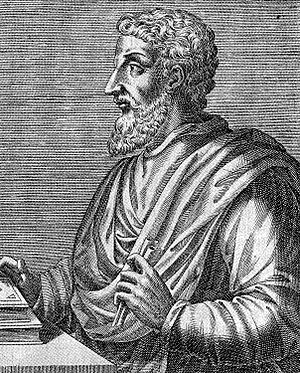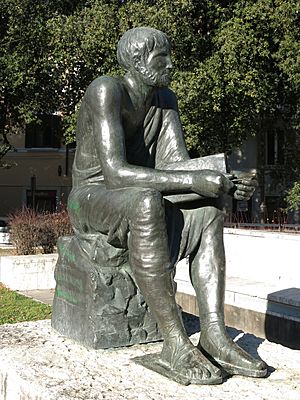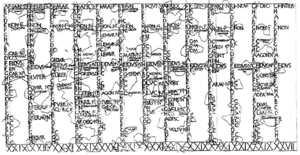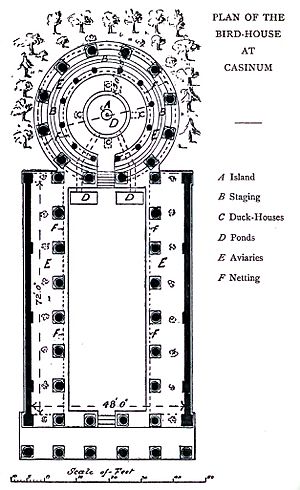Marcus Terentius Varro facts for kids
Marcus Terentius Varro (born 116 BC, died 27 BC) was a very smart and busy Roman writer. He was like a "jack-of-all-trades" because he knew a lot about many different subjects. People in ancient Rome thought he was their greatest scholar. A famous writer named Petrarch even called him "the third great light of Rome," after Virgil and Cicero. Sometimes, people called him Varro Reatinus to tell him apart from another writer named Varro Atacinus.
Contents
Varro's Life Story

Varro was born near Reate (which is now called Rieti) in Italy. His family was likely from the equestrian class. This was a group of wealthy Roman citizens, often involved in business or the military. Varro always stayed close to his hometown. He owned a large farm in the Reatine plain for most of his life.
Varro supported a powerful Roman general named Pompey. He held several important government jobs. He was a quaestor (who managed money), a curule aedile (who oversaw public works), a tribune of the plebs (who protected common people's rights), and a praetor (a high-ranking judge or military commander).

During the Roman civil war, Varro commanded one of Pompey's armies. Even though he was on the losing side, Julius Caesar pardoned him twice. After this, Caesar appointed Varro to manage Rome's public library in 47 BC.
However, after Caesar was killed, another powerful Roman, Mark Antony, declared Varro an enemy of the state. This meant Varro lost much of his property, including his valuable library. Later, as the Roman Republic changed into an Empire, Varro gained the support of Augustus. Under Augustus's protection, Varro found peace and security. This allowed him to focus on his studies and writing.
Varro studied with important teachers. He learned from Lucius Aelius Stilo, a Roman expert in language. He also studied philosophy in Athens with Antiochus of Ascalon. Varro became an incredibly productive writer. He wrote more than 74 Latin works on many different subjects.
Two of his most important works for historians are his Nine Books of Disciplines and his Varronian chronology. His Nine Books of Disciplines became a guide for later writers who created encyclopedias. This work was special because it used the idea of "liberal arts" to organize knowledge. Varro listed nine of these arts: grammar, rhetoric, logic, arithmetic, geometry, astronomy, music, medicine, and architecture. Later writers used Varro's list to define the seven main "liberal arts" taught in medieval schools.
In his old age, around 37 BC, Varro wrote a large book about farming for his wife, Fundania. This book, called De re rustica (or Three Books on Agriculture), gave advice on managing large farms that used enslaved workers.
Roman Calendars and History

Varro worked hard to create an exact timeline of Roman history. This timeline, called the Varronian chronology, listed events year by year up to his time. It was based on the traditional list of Roman consuls. Sometimes, he added "dictatorial" or "anarchic" years when needed.
Even though it has some small errors, Varro's timeline became the accepted standard for Roman history. This was largely because it was carved onto the Arch of Augustus in Rome. Even though that arch is gone today, a big part of Varro's timeline still exists. It is known as the Fasti Capitolini.
Varro's Writings
Varro wrote a huge number of books. One expert, Ritschl, estimated he wrote 74 works in about 620 books! Sadly, only one of his works has survived completely. We do have many small parts (fragments) of his other books.
The Roman writer Quintilian called Varro "the most learned of the Romans." Plutarch also said he was "a man deeply read in Roman history." Many other ancient authors used Varro as an important source for their own writings. These authors include Cicero, Pliny the Elder, Virgil, Columella, Aulus Gellius, Macrobius, Augustine, and Vitruvius. Vitruvius even mentioned that Varro wrote a book about architecture.
Varro's only complete book that still exists is Rerum rusticarum libri tres (Three Books on Agriculture). This book has been described as a well-organized guide from an experienced farmer. It shows that Varro had seen and practiced everything he wrote about.
One amazing thing about this book is that Varro seemed to have an early idea about tiny living things that cause sickness. This was long before modern microbiology was understood.
Books We Still Have
- Rerum rusticarum libri III (or Agricultural Topics in Three Books)
Books We Know About (But Are Lost)
- Saturarum Menippearum libri CL (Menippean Satires in 150 books) - These were funny and critical writings.
- Antiquitates rerum humanarum et divinarum libri XLI (Antiquities of Human and Divine Things) - A huge work about Roman history, religion, and daily life.
- Disciplinarum libri IX (Nine Books of Disciplines) - An encyclopedia about the liberal arts.
- De rebus urbanis libri III (On Urban Topics in Three Books) - About city life.
- De sua vita libri III (On His Own Life in Three Books) - Varro's autobiography.
- De Origine Linguae Latinae libri III (On the Origin of the Latin Language) - About where Latin words came from.
Most of the small parts of these lost works can be found in special collections by scholars.
See also
 In Spanish: Varrón para niños
In Spanish: Varrón para niños


